Le Ministère des Pensions
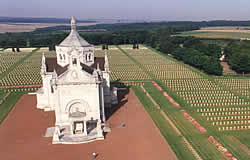
|
Le Ministère des Pensions is the French war graves agency which cares for the French military cemeteries from the 1914-1918 war to the present day. There are 265 cemeteries in France classed as “nécropoles nationales” - national cemeteries - for those who have died for France, “Mort pour la France”. These cemeteries contain the remains of almost 730,000 bodies, of which 240,000 are in ossuaries, who served with the French army from 1855 to 1986. It includes members of the Resistance, deportees and foreigners who fought under the French flag in the wars of 1870-71, 1914-18 and 1939-45.
History of the French War Graves Agency
December 1915
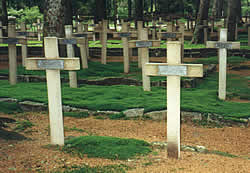
|
On 29th December 1915 a law was passed giving the right to a perpetual resting place on French soil to any soldier in the French Army or Allied Army who had died for France.
February 1916
Faced with an enormous number of losses of French soldiers in 1914-1915 the French government set up the Service Général des Pensions on 18th February 1916. During the First World War this government department was part of the War Ministry.
November 1918
On 25th November 1918 a national commission for military graves was established to oversee the reorganisation of the national military cemeteries and sepulchures to conform to a standard architectural and horticultural style. Each cemetery was to be laid out with a central pathway containing a flagpole for the national flag. Concrete crosses or marker stones were to replace original grave markers, these generally being wooden crosses made by the military burial parties.
1920-1935
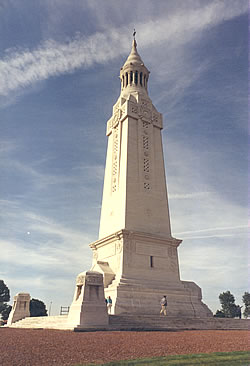
|
On 27th January, 1920 the Ministère des Pensions was created and it took over responsibility for looking after the military graves and sepulchres.
On 11th November 1920 the French 'unknown soldier' (le Soldat Inconnu) was laid in the tomb under the Arc de Triomphe in Paris.
By the end of 1925 the Ministère des Pensions had carried out 960,000 exhumations from the old First World War battlefields and smaller burial sites. 22,000 bodies of German prisoners of war had been repatriated to Germany for reburial.
1939-1946
In September 1939 the graves service was moved to the War Ministry again. With the liberation of France in 1944 and the end of the war in Europe in May 1945 the responsibility for looking after the military burial sites was passed to the local civilian goverment offices of each of the regional Departments.
A law was passed on 16 October 1946 which gave parents the right to remove a soldier from a military cemetery and take him home for reburial. About 125,000 soldiers killed in the First and Second World Wars were removed from military sites at about that time. This law also applied to more recent conflicts involving French troops in Indochina, Korea and Madagascar.
Design and Construction of French Military Cemeteries
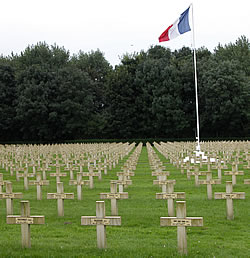
|
The same basic design is to be found in all the national military cemeteries.
Graves
In the French Republican tradition of Egalité - equality - all graves are intended to be identical; no grave is to be embellished in any way more than another, although it is permitted to leave cut flowers at a grave.
Ossuaries
Non-identified soldiers are buried in a communal grave. If it is known that a soldier's remains have been buried in the communal grave, for example his remains could not be identified within the crew of a tank or aeroplane, his name is given.
Monuments
Memorials to individuals or regiments have been erected by families or regimental associations.
Grave Marker
The symbol of a concrete Latin Cross for soldiers of the Christian faith was continued on from the tradition adopted by soldiers of erecting a wooen cross to mark a battlefield grave. For soldiers of other religions denominations, where it was known from a soldier's pay book or regimental service record, a gravestone replaced the cross. The gravestones of muslim soldiers are angled slightly in the row to face east.
Horticulture
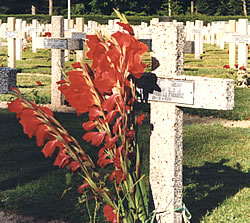
|
After 1918 the French cemeteries were reconstructed. Wooden grave markers were replaced and gravel was laid. Initially the mound of each grave was marked by a border of carnations. Shortly before the Second World War and during the 1950s grass lawns and plants were introduced to the cemeteries. The 'polyanthas' rose was the most commonly adopted flower because it flowered abundantly with red blooms from the spring to the early frosts of autumn. Decorative landscaping with trees and shrubs has been carried out in some cemeteries more recently.
Discovery of French Soldiers
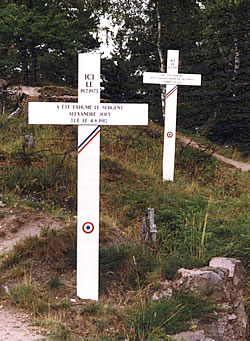
|
If a soldier's body is discovered today in a previously unknown location he is buried in the nearest national military cemetery. If he can be identified he is buried in an individual grave but if the remains are unidentifiable except that he is a French soldier he is buried in the ossuary.
Mémoire des Hommes Website
In memory of the many thousands of French servicemen who have served their country at times of conflict since 1914 the French Ministry of Defence has provided a website (in French, English, German and Spanish) providing thousands of digitalized biographical records. Visit the website at
Website: Mémoire des Hommes
Contact Details for the French War Graves Agency
For information about the National Commission for French Military Graves contact:
Address: Ministère des anciens Combattants et Victimes de Guerre, Délégation à la Mémoire et à l'Information Historique, 37, rue de Bellechasse, 75007 Paris, France
Related Topics
Ablain St-Nazaire French Military Cemetery
For information and pictures of the largest French military cemetery in the world see our page at:
Ablain St-Nazaire French Military Cemetery
War Graves for WW1 Dead on The Western Front
War Graves for WW1 Dead on The Western Front
Acknowledgements
Text translated from Atlas des Nécropoles Nationales